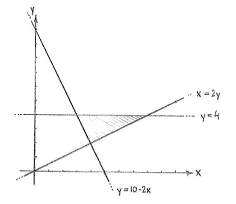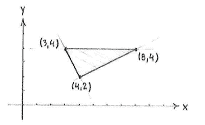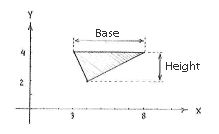Lösung 2.2:9b
Aus Online Mathematik Brückenkurs 1
K (hat „Solution 2.2:9b“ nach „Lösung 2.2:9b“ verschoben: Robot: moved page) |
|||
| Zeile 1: | Zeile 1: | ||
| - | + | Zuerst zeichnen wir die Geraden, sodass wir sehen wie das Dreieck aussieht. | |
| - | + | ||
[[Image:2_2_9_b-1(3).gif|center]] | [[Image:2_2_9_b-1(3).gif|center]] | ||
| - | + | Die Ecken dieses Dreiecks, sind die Schnittpunkte des Geraden. Wir erhalten die Schnittstellen wenn wir die Gleichungen der Geraden für alle 3 Paare von geraden lösen. | |
| - | + | ||
{{Abgesetzte Formel||<math>\left\{\begin{align} x&=2y,\\ y&=4,\end{align}\right.\qquad | {{Abgesetzte Formel||<math>\left\{\begin{align} x&=2y,\\ y&=4,\end{align}\right.\qquad | ||
| Zeile 12: | Zeile 10: | ||
\left\{\begin{align} y&=4,\\ y&=10-2y\,\textrm{.}\end{align}\right.</math>}} | \left\{\begin{align} y&=4,\\ y&=10-2y\,\textrm{.}\end{align}\right.</math>}} | ||
| - | + | Die Gleichungssysteme haben die Lösungen <math>(x,y) = (8,4)</math>, <math>(x,y) = (4,2)</math> und <math>(x,y) = (3,4)\,</math>. | |
| - | + | ||
[[Image:2_2_9_b-2(3).gif|center]] | [[Image:2_2_9_b-2(3).gif|center]] | ||
| + | Die Fläche des Dreiecks bekommen wir mit der Gleichung | ||
| - | + | {{Abgesetzte Formel||<math>\text{Fläche} = \tfrac{1}{2}\cdot\text{(Basis)}\cdot\text{(Höhe),}</math>}} | |
| - | + | ||
| - | {{Abgesetzte Formel||<math>\text{ | + | |
| - | + | Nachdem hier eine Kante mit der ''x''-Achse parallel ist, wählen wir diese Kante als Basis des Dreiecks. | |
| Zeile 29: | Zeile 25: | ||
| - | + | Die Basis ist einfach der Unterschied zwischen den ''x''-Koordinaten (3,4) und (8,4), | |
{{Abgesetzte Formel||<math>\text{base} = 8-3 = 5</math>}} | {{Abgesetzte Formel||<math>\text{base} = 8-3 = 5</math>}} | ||
| - | + | Wir erhalten die Höhe des Dreiecks als der Unterschied zwischen den ''x''-Koordinaten von dem Punkt (4,2) und von der Gerade <math>y=4</math> | |
{{Abgesetzte Formel||<math>\text{height} = 4-2 = 2\,\textrm{.}</math>}} | {{Abgesetzte Formel||<math>\text{height} = 4-2 = 2\,\textrm{.}</math>}} | ||
| - | + | Die Fläche des Dreiecks ist also | |
{{Abgesetzte Formel||<math>\text{Area} = \tfrac{1}{2}\cdot\text{(base)}\cdot\text{(height)} = \tfrac{1}{2}\cdot 5\cdot 2 = 5\,\text{u.a.}</math>}} | {{Abgesetzte Formel||<math>\text{Area} = \tfrac{1}{2}\cdot\text{(base)}\cdot\text{(height)} = \tfrac{1}{2}\cdot 5\cdot 2 = 5\,\text{u.a.}</math>}} | ||
Version vom 13:30, 13. Mär. 2009
Zuerst zeichnen wir die Geraden, sodass wir sehen wie das Dreieck aussieht.
Die Ecken dieses Dreiecks, sind die Schnittpunkte des Geraden. Wir erhalten die Schnittstellen wenn wir die Gleichungen der Geraden für alle 3 Paare von geraden lösen.
| \displaystyle \left\{\begin{align} x&=2y,\\ y&=4,\end{align}\right.\qquad
\left\{\begin{align} x&=2y,\\ y&=10-2y,\end{align}\right.\qquad \text{and}\qquad \left\{\begin{align} y&=4,\\ y&=10-2y\,\textrm{.}\end{align}\right. |
Die Gleichungssysteme haben die Lösungen \displaystyle (x,y) = (8,4), \displaystyle (x,y) = (4,2) und \displaystyle (x,y) = (3,4)\,.
Die Fläche des Dreiecks bekommen wir mit der Gleichung
| \displaystyle \text{Fläche} = \tfrac{1}{2}\cdot\text{(Basis)}\cdot\text{(Höhe),} |
Nachdem hier eine Kante mit der x-Achse parallel ist, wählen wir diese Kante als Basis des Dreiecks.
Die Basis ist einfach der Unterschied zwischen den x-Koordinaten (3,4) und (8,4),
| \displaystyle \text{base} = 8-3 = 5 |
Wir erhalten die Höhe des Dreiecks als der Unterschied zwischen den x-Koordinaten von dem Punkt (4,2) und von der Gerade \displaystyle y=4
| \displaystyle \text{height} = 4-2 = 2\,\textrm{.} |
Die Fläche des Dreiecks ist also
| \displaystyle \text{Area} = \tfrac{1}{2}\cdot\text{(base)}\cdot\text{(height)} = \tfrac{1}{2}\cdot 5\cdot 2 = 5\,\text{u.a.} |



